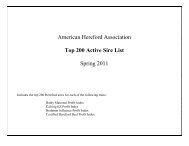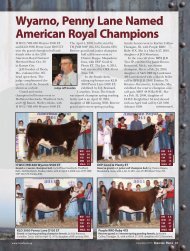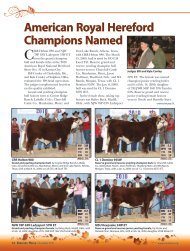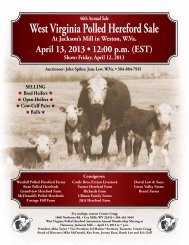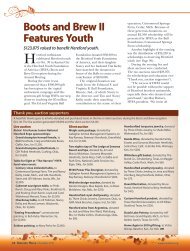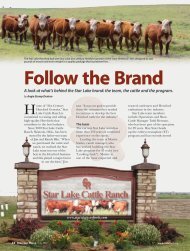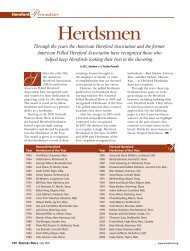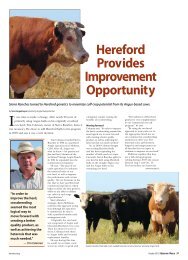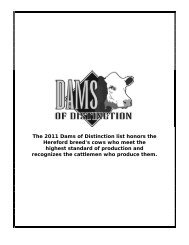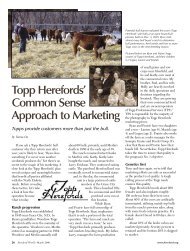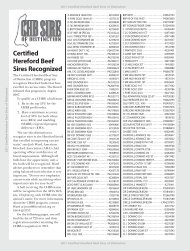Calving Season
Calving Season
Calving Season
Create successful ePaper yourself
Turn your PDF publications into a flip-book with our unique Google optimized e-Paper software.
Focus on <strong>Calving</strong><br />
Getting Ready for<br />
<strong>Calving</strong> <strong>Season</strong><br />
by Troy Smith<br />
Generally, cow folk look<br />
forward to calving<br />
season. Most enjoy the<br />
sense of renewal that comes with<br />
the arrival of a new calf crop.<br />
They’re anxious for a first look<br />
at the results of time and money<br />
invested in genetic selection.<br />
And often, they’re relieved when<br />
calving season is over — especially<br />
if it was accompanied by foul<br />
weather, complicated deliveries,<br />
or extraordinary amounts of calf<br />
sickness and deaths.<br />
Sooner or later, every<br />
producer faces some amount<br />
of calving trouble. Challenges<br />
should be expected, so savvy<br />
producers make the most of<br />
calving season by planning<br />
appropriate responses. Some<br />
problems may be avoided, or<br />
at least reduced, with sufficient<br />
preparation before that first heifer<br />
or cow gets the urge to calve.<br />
Common sense and good<br />
management are the best tools<br />
producers can apply, according to<br />
veterinarian Scott Reynolds, who<br />
practices in Broken Bow, Neb., and<br />
also manages a 100-cow springcalving<br />
herd. Reynolds says it just<br />
makes sense to evaluate body<br />
condition and manage nutrition to<br />
have the herd prepared.<br />
“I advise producers to monitor<br />
body condition continuously<br />
and make sure cows reach a<br />
body condition score (BCS) of<br />
at least 5 and preferably 6 well<br />
ahead of calving time,” Reynolds<br />
says. “Fetal programming<br />
studies indicate nutrition of the<br />
pregnant cow influences how<br />
her developing calf will perform<br />
throughout its life. When cows<br />
are in proper condition, their<br />
calves generally get up quicker<br />
and suckle faster. The volume and<br />
quality of cow colostrum will be<br />
better. That’s also important to<br />
lifetime health and performance<br />
of her calf.”<br />
Reynolds says adequate body<br />
condition ensures cows will have<br />
enough energy for the laborious<br />
task of delivering a calf. A thin<br />
cow may weaken and give up<br />
during labor. Additionally, cows<br />
below BCS 5 at rebreeding exhibit<br />
lower conception rates.<br />
“We have seen the<br />
repercussions in our practice,”<br />
Reynolds says. “In 2009, feed<br />
quality was generally lower and<br />
a higher percentage of area cows<br />
were thinner at calving and at<br />
rebreeding. We saw more open<br />
cows at preg-check — 50 to 75%<br />
more — especially among young<br />
(first- and second-calvers) and<br />
old cows whose nutritional needs<br />
probably weren’t met.”<br />
Reynolds advises producers<br />
to have feedstuffs analyzed and<br />
Whether spring or fall calving, keeping an eye on the herd can help producers catch those cows that need help before it is too late.<br />
Photo by BECKY HARRELL<br />
Make sure facilities<br />
are clean and in good<br />
repair. Find the calf<br />
chains, handles and<br />
calf puller. Have them<br />
cleaned and ready,<br />
along with obstetrical<br />
sleeves and lubricant.<br />
provide necessary energy, protein<br />
and mineral supplementation.<br />
He urges particular attention<br />
to cow diets during the last<br />
trimester of gestation.<br />
Be prepared<br />
Assuming the cows are<br />
nutritionally ready, producers<br />
should make preparations for<br />
when a cow needs assistance with<br />
delivery. Make sure facilities are<br />
clean and in good repair. Find<br />
the calf chains, handles and calf<br />
puller. Have them cleaned and<br />
ready, along with obstetrical<br />
sleeves and lubricant.<br />
It’s a good idea to have a<br />
supply of frozen colostrum or<br />
commercial colostrum “product”<br />
on hand, says Dee Whittier,<br />
Extension veterinarian and<br />
professor at the Virginia-Maryland<br />
Regional College of Veterinary<br />
Medicine, Blacksburg, Va.<br />
“The real thing is always best,<br />
when you can get it by milking out<br />
a just-calved cow. Or, sometimes a<br />
producer can get frozen colostrum<br />
from a nearby dairy,” says Whittier.<br />
“There are a bunch of colostrum<br />
products available, but look at<br />
the label and choose a colostrum<br />
‘replacement’ rather than a<br />
‘supplement.’” (See also story about<br />
colostrum, Page 20.)<br />
Observing the herd<br />
Once a producer has readied<br />
the facilities, equipment and<br />
supplies, it’s a matter of observing<br />
the herd. Whittier says the first<br />
calves are likely to arrive about<br />
270 days after cows were exposed<br />
to a bull. He reminds producers<br />
that selection for calving ease<br />
has been accompanied by<br />
shorter gestation periods. Since<br />
heifers are generally bred to<br />
calving ease bulls, they should<br />
be observed accordingly.<br />
“Heifers might calve 10 days<br />
earlier and sometimes sooner<br />
than that,” Whittier warns.<br />
Indicators that parturition is<br />
near may include “springing” —<br />
the relaxation and enlargement of<br />
the vulva. A relaxation of muscles<br />
around the tail head also occurs<br />
but is less evident among animals<br />
with more fat cover. A little better<br />
indicator, says Whittier, is the<br />
18 / January 2012 www.hereford.org
filling of the udder and teats. Often,<br />
when the teats become filled with milk,<br />
calving may be only a day or two away.<br />
“Very near signs might be apparent<br />
discomfort and nervousness — especially<br />
in first-calf heifers — and an increase<br />
in vaginal discharge,” Whittier adds.<br />
“And cows and heifers tend to isolate<br />
themselves just prior to calving. That’s a<br />
pretty reliable sign.”<br />
Both Whittier and Reynolds advise<br />
producers to become familiar with<br />
the stages of parturition in order<br />
to gauge an animal’s progress and<br />
determine if and when intervention<br />
is needed. During the first stage,<br />
the calf should rotate to an upright<br />
position and the mother’s cervix<br />
dilates. Uterine contractions begin<br />
during this preparatory stage and the<br />
water sac is expelled.<br />
“The first stage may take only a<br />
couple of hours, but it could take eight<br />
to 10 hours,” Whittier explains. “If<br />
you check in the morning and find a<br />
cow in the first stage, she should be<br />
progressing with delivery by noon. If<br />
not, an examination is probably in<br />
order. But before sticking an arm in<br />
there, wash the vaginal area with soapy<br />
water, tie her tail out of the way and<br />
use a clean plastic sleeve with plenty<br />
of OB lube. If examination reveals the<br />
cervix is not completely dilated, she<br />
may need a couple more hours.”<br />
In some instances, cautions<br />
Whittier, a calf might be in an<br />
abnormal position that does not<br />
stimulate the second stage of labor, so<br />
assistance is needed.<br />
The second stage of parturition<br />
involves the actual delivery. The calf<br />
enters the birth canal and, typically,<br />
the cow will lie down and strain<br />
with the contractions. In a normal<br />
presentation, the calf’s nose and<br />
forefeet protrude first, followed by<br />
passage of the shoulders and then the<br />
hips. First-calf heifers may require up<br />
to two hours, but mature cows often<br />
deliver in an hour or less.<br />
“If she’s in stage two, you ought to<br />
see progress. If there’s been no real<br />
progress in a half-hour, assistance<br />
is probably needed and it’s time to<br />
act,” warns Reynolds, stressing that<br />
producers facing dystocia (calving<br />
difficulty) need to know their<br />
limitations. “If they’re not experienced<br />
in assisting delivery and especially<br />
if they have no experience with<br />
abnormal presentations, they should<br />
call in a veterinarian.”<br />
The third stage of calving is<br />
expulsion of the placenta, which<br />
normally occurs within eight hours<br />
after delivery of the calf. If it hasn’t<br />
happened in 48 hours, consult<br />
a veterinarian. Treatment with<br />
antibiotics may be prescribed to fight<br />
infection, and removal of a retained<br />
placenta is sometimes necessary.<br />
The calf<br />
Newborn calves that are weak<br />
following a difficult delivery or other<br />
stress often require attention. Whittier<br />
says any newborn that hasn’t stood<br />
and nursed within a couple of hours<br />
probably needs help, but dystociaaffected<br />
calves are often exhausted<br />
and may even suffer from a little brain<br />
damage. It may be necessary to teach<br />
them how to nurse.<br />
“Calves lost within two days<br />
after birth usually die because of<br />
starvation, hypothermia or both,”<br />
states Whittier. “Hypothermia can<br />
be prevented in a lot of ways — in a<br />
pickup cab or under a heat lamp —<br />
but a warming box is one of the best<br />
ways to warm a chilled calf.”<br />
A warming box doesn’t have to<br />
be fancy. Whittier says an enclosure<br />
(about 3ʹ × 3ʹ × 4ʹ) with an electric<br />
hairdryer as a heat source can create<br />
a 100-degree environment that warms<br />
a calf quickly. But you can kill a calf<br />
by overheating it. He recommends<br />
using a rectal thermometer to check a<br />
calf’s temperature, calling 100 degrees<br />
(Fahrenheit) warm enough.<br />
Whittier and Reynolds emphasize<br />
the importance of getting colostrum<br />
or a suitable colostrum replacement<br />
product into a stressed newborn as<br />
soon as possible. Reynolds warns<br />
against thawing frozen colostrum in<br />
a microwave oven, as extreme heat<br />
destroys antibodies it contains. Rather,<br />
he recommends placing the container<br />
of frozen colostrum in warm water and<br />
allowing it to thaw slowly.<br />
“I recommend feeding a quart of<br />
colostrum within the first hour after<br />
birth. Don’t try to feed two quarts<br />
all at once. A second quart can be<br />
given during the next four to six<br />
hours,” Reynolds explains. “And it’s<br />
better if the calf suckles it from a<br />
bottle rather than administering with<br />
a tube. If colostrum is tube-fed and<br />
it gets in baby calf’s rumen instead<br />
of the abomasum, there is virtually<br />
no absorption and no transfer of<br />
immunity to the calf.”<br />
Scour prevention<br />
Reynolds and Whittier also agree that<br />
preparation for calving season ought to<br />
include some thought about preventing<br />
calf scours. They believe the most<br />
important thing a producer can do<br />
is take steps to limit calf exposure to<br />
disease-causing organisms.<br />
“I started my veterinary career in<br />
Saskatchewan (Canada), where most<br />
calves were born in calving barns<br />
during cold weather,” Whittier says.<br />
“But we found that calves born outside,<br />
on clean ground, were less likely to<br />
get sick. In the calving barns, calves<br />
were exposed to all kinds of bugs that<br />
cause scours. So I think the Sandhills<br />
<strong>Calving</strong> System is good.”<br />
The Sandhills <strong>Calving</strong> System,<br />
developed by the University of<br />
Nebraska, is based on the idea that<br />
environmental pathogen levels are<br />
relatively low at the start of calving<br />
season. However, a few of the first<br />
calves become infected and shed<br />
large numbers of pathogens into the<br />
environment, increasing the risk of<br />
exposure to calves born later. More<br />
calves become infected and shed even<br />
greater numbers of pathogens, and the<br />
incidence of scours increases as calving<br />
season progresses.<br />
Put into practice, the System calls<br />
for removal of cows that have not yet<br />
calved to a different clean pasture<br />
after the first week or 10 days of<br />
calving season. Existing pairs remain<br />
in the pasture where those earliest<br />
calves were born. The process then<br />
continues throughout the calving<br />
season, although the resulting<br />
different groups of pairs can be<br />
commingled after calves reach four<br />
weeks of age.<br />
The complaint among many<br />
producers, says Whittier, is that<br />
multiple calving pastures are<br />
required. Reynolds concurs, noting<br />
that many of his Nebraska clients<br />
aren’t set up to fully implement the<br />
Sandhills <strong>Calving</strong> System.<br />
“But even if a producer sorts<br />
heavies into a different pasture only<br />
one time, it really helps,” states<br />
Whittier. “Just having one more<br />
pasture available and splitting the<br />
herd one time can help reduce the<br />
younger calves’ exposure to bugs<br />
shed by older calves. And the larger<br />
the herd is, the more good it does.”<br />
Also to help protect calf health,<br />
Reynolds warns against buying a sale<br />
“We found that calves born outside, on clean ground,<br />
were less likely to get sick. In the calving barns, calves<br />
were exposed to all kinds of bugs that cause scours.<br />
So I think the Sandhills <strong>Calving</strong> System is good.”<br />
— Dee Whittier<br />
<strong>Calving</strong> season preparation also includes taking steps to prevent scours by limiting calf exposure to<br />
disease-causing organisms.<br />
barn calf to foster onto a cow that<br />
has lost her own baby. By doing so, a<br />
producer may be buying trouble.<br />
“I think it’s a big mistake,” Reynolds<br />
says. “You don’t know if the calf<br />
received colostrum or not, but you<br />
can be sure it was exposed to all kinds<br />
of pathogens. You might bring home<br />
disease organisms you’ve never had on<br />
your place before. It’s not worth the<br />
risk.”<br />
On a final note, Whittier says<br />
he hears producers complain that a<br />
veterinarian was reluctant to come<br />
when summoned to help with a<br />
difficult calving. But there may be a<br />
good reason.<br />
“Maybe the last time a<br />
veterinarian heard from one of<br />
those producers was two years ago,<br />
at midnight, on Christmas Eve.<br />
The producer probably waited too<br />
long before calling, so things were<br />
already a mess,” suggests Whittier.<br />
“Producers should consult with their<br />
veterinarian, buy products from him<br />
(or her) and develop a relationship.<br />
It can make a difference when you<br />
need some professional expertise on<br />
a cold, dark night.” HW<br />
Photo by Mike Choate<br />
www.hereford.org January 2012 / 19



